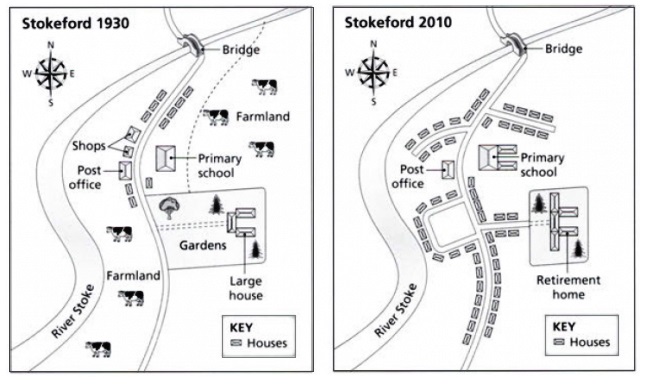IELTS map questions are a breeze to answer. Instead of analyzing numbers, you only need to compare 2 or 3 maps. Occasionally, you may come across a question with just a single map, but this is rare.
The maps will depict the same location at different points in time. It could be in the past, present, or even a plan for future development. Your task is to write about the changes you observe between the maps.
5 Steps to Writing a High-Scoring IELTS Map Essay
Before we dive into the practice question, let’s go through the 5 stages step-by-step.
Step 1 – Analyze the Question
All Academic Task 1 questions follow the same format. Highlighted are the words that will be included in all questions.
Sentence 2 tells you what you have to do.
You must:
- Identify the main features of the graphic
- Compare the main features
- Report only the main features
Focus on the ‘main features’ and select 2 or 3 key ones to write about.
Step 2 – Identify the Main Features
Start with the earliest map and identify the key features. Observe how they have changed in the later map, and if applicable, the final map.
Ask yourself these questions:
- What are the key changes?
- What is the direction of the changes?
Here are the main features identified in our sample maps:
- Loss of shops
- Disappearance of farmland
- Enlargement of the school
- Development of the large house into a retirement home
Your selected key features will serve as the foundation for your IELTS map essay. More details can be added later, but with only 20 minutes and a required word count of 150, keep it concise.
Step 3 – Write an Introduction
Paraphrase the question in the introduction. Use synonyms and change the sentence structure. For example:
“This is all you need to do for the introduction.”
Step 4 – Write an Overview (Paragraph 2)
In the second paragraph, describe the general changes that have taken place. Save the details for later. Keep it simple with the appropriate words and verb tenses.
For example:
“In the sample maps, the key changes include the loss of shops, disappearance of farmland, enlargement of the school, and development of the large house into a retirement home. These changes can be observed over time.”
Step 5 – Write the 1st Detail Paragraph
In paragraphs 3 and 4, provide evidence to support your first 1 or 2 key features. If the features are closely related, write about them together.
Here are the key features we identified:
- Loss of shops
- Enlargement of the school
For example:
“The first noticeable change was the loss of shops. In the initial map, there were several shops present, but in the later map, they had vanished. On the other hand, the school experienced significant growth. It went from a small building to a much larger one in the later map.”
Step 6 – Write the 2nd Detail Paragraph
For the final paragraph, address the remaining key features.
Here are the remaining features:
- Disappearance of farmland
- Development of the large house into a retirement home
For example:
“Another significant change was the disappearance of farmland. In the initial map, vast fields could be seen, but in the later map, they had been replaced by residential areas. Lastly, the large house underwent a transformation, becoming a retirement home for the elderly.”
And that’s it! You have successfully written your IELTS map essay using the 5-step process. Keep in mind that due to the word limit, focus on a couple of main features and practice until you can do it in around 20 minutes.
To further improve your IELTS writing skills, visit testtoeic.com for free TOEIC and English grammar tests.
Remember, practice makes perfect!
